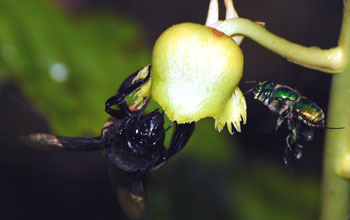Multimedia Gallery
CEIBA Research, Guyana (Image 6)
Euglossine bees (Eulaema sp.), also called orchid bees, are a solitary species, with few living communally. All live exclusively in South or Central America. The male orchid bee has modified legs that are used to collect and store fragrant compounds, generally from orchids. These compounds are metabolized to attract females, who then select the male with the most fragrant bouquet of perfumes.
Interestingly, orchid bees are the only group of pollen-carrying bees that do not possess eusocial behavior--specialized reproduction found in some animals that involves breeding sterile members of a species to carry out specialized tasks and care for the reproductive members. There are about 200 known species that are distributed in five genera: Euglossa, Eulaema, Eufriesea, Exaerete and Aglae. The latter two species are cleptoparasites (creatures that take prey from other species that have caught, killed or prepared it, including stored food provisions), and live in the nests of other orchid bees.
This image was taken as part of research centered at the CEIBA Biological Center, Inc. in Guyana, by Professor Godfrey Bourne of the department of biology at the University of Missouri-St. Louis. Bourne is currently program director of the Behavioral Systems Cluster, Division of Integrative Organismal Biology at the National Science Foundation.
Bourne is personally involved in administrating the CEIBA Biological Center Inc. as a nonprofit research, education and conservation field station in Guyana. Research opportunities for postdoctoral associates, graduate and undergraduate students are available in Guyana on a diversity of organisms.
This research was supported in part by the National Science Foundation. [One of several related images. See next image Here.] (Date of Image: 2004-2006)
Credit: Photo by Godfrey R. Bourne
Images and other media in the National Science Foundation Multimedia Gallery are available for use in print and electronic material by NSF employees, members of the media, university staff, teachers and the general public. All media in the gallery are intended for personal, educational and nonprofit/non-commercial use only.
Images credited to the National Science Foundation, a federal agency, are in the public domain. The images were created by employees of the United States Government as part of their official duties or prepared by contractors as "works for hire" for NSF. You may freely use NSF-credited images and, at your discretion, credit NSF with a "Courtesy: National Science Foundation" notation.
Additional information about general usage can be found in Conditions.
Also Available:
Download the high-resolution JPG version of the image. (1.1 MB)
Use your mouse to right-click (Mac users may need to Ctrl-click) the link above and choose the option that will save the file or target to your computer.



